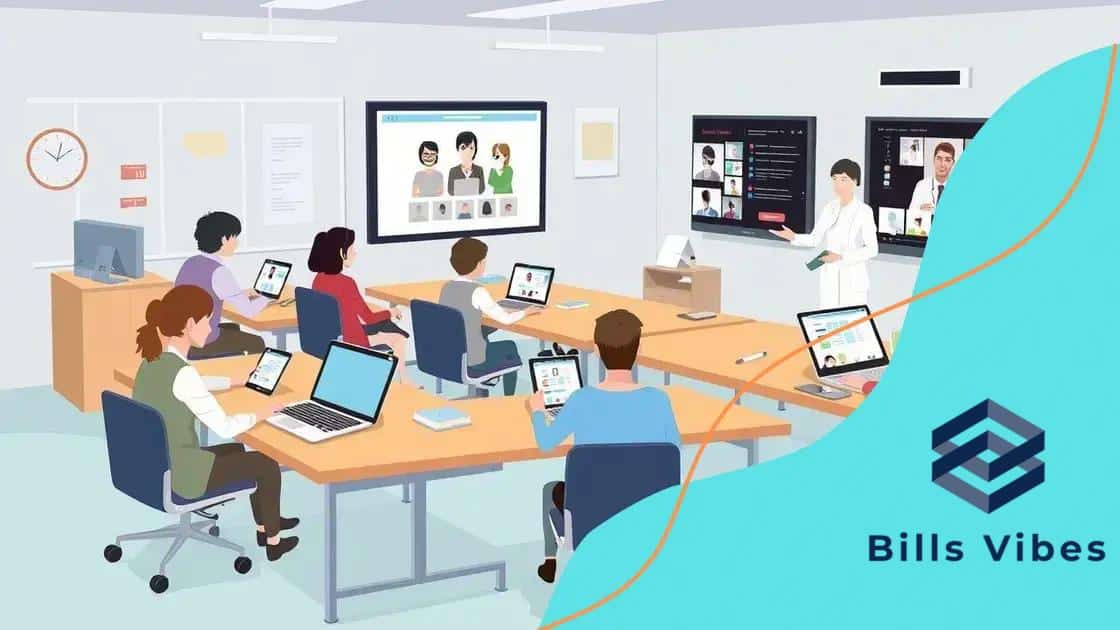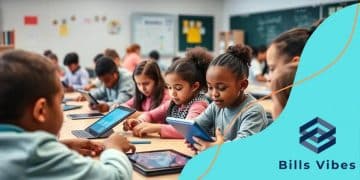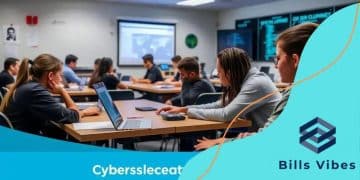New trends in hybrid learning: what you need to know

New trends in hybrid learning combine online and in-person instruction, enhancing flexibility, student engagement, and personalized learning experiences through advanced technologies and collaborative tools.
New trends in hybrid learning are changing the face of education, combining the flexibility of online classes with the personal touch of in-person sessions. Have you ever wondered how this approach can enhance your learning experience? Let’s dive into this exciting method!
Understanding hybrid learning methods
Understanding hybrid learning methods is essential for grasping how technology is shaping education today. Hybrid learning combines traditional classroom experiences with online instruction, offering flexibility and accessibility for students.
This dual approach encourages greater engagement and caters to different learning styles. To fully appreciate hybrid learning methods, we can break down their components.
Key Aspects of Hybrid Learning
Incorporating various methods enhances the overall learning experience. Here are some key aspects:
- Flexibility: Students can choose when and where they learn.
- Personalization: Educators can tailor content to meet individual needs.
- Collaboration: Students can collaborate with peers in different locations.
- Technology Integration: Utilizing digital tools and platforms enhances understanding.
Hybrid learning also allows for the use of resources that traditional classrooms might not access. For instance, educators can incorporate multimedia tools to enrich lessons and promote active participation. Students can also benefit from interactive forums and virtual group projects, making learning more dynamic.
Moreover, hybrid learning methods can lead to increased motivation. When students have a say over their learning environment and pace, they often feel more invested in their education. This autonomy encourages them to take responsibility for their learning journey.
As we explore the various techniques within hybrid learning, it’s crucial to acknowledge that its success hinges on effective communication and support between instructors and students. By fostering a collaborative atmosphere, educators can bridge the gap between online and face-to-face interactions.
Challenges of Hybrid Learning
Like any educational model, hybrid learning comes with challenges:
- Technology access: Not all students may have the required devices or internet connectivity.
- Instructor training: Educators need support to effectively use online tools.
- Student engagement: Maintaining attention can be harder in virtual settings.
Addressing these challenges is vital for maximizing the potential of hybrid learning methods. Institutions should provide resources and training to ensure a seamless transition between online and in-person instruction.
Benefits of hybrid learning for students
Benefits of hybrid learning for students are increasingly recognized as education evolves. This model combines the best of both worlds, allowing students to experience in-person interaction while also enjoying the flexibility of online learning.
One significant advantage is that hybrid learning accommodates different learning styles. Some students thrive in a traditional classroom environment, while others prefer the independence offered by online classes. This approach ensures that all students can achieve their personal best.
Flexibility and Convenience
Students benefit from the flexibility of setting their schedules. They can choose when to attend live classes and when to study online. This flexibility allows them to balance educational commitments with other activities.
- Adjustable learning pace: Students can learn at their own speed.
- Access to materials anytime: Resources are available online 24/7.
- Reduced travel time: Students save time by engaging in remote sessions.
Another essential benefit is the range of resources available to students. Hybrid learning models often encourage the integration of various online tools that enhance the educational process. With access to multimedia content, students can engage with diverse materials to deepen their understanding.
Furthermore, hybrid learning fosters improved collaboration among students. Group projects and online forums allow students to connect with peers regardless of their location. Building connections enhances teamwork skills, which are critical in today’s workforce.
Enhanced Engagement and Motivation
Students are often more engaged when they can participate in hybrid learning. The interactive elements of technology attract attention and spark interest in learning. Engaging formats like videos, quizzes, and virtual discussions make lessons enjoyable.
- Increased participation: Students are more likely to engage in discussions.
- Real-time feedback: Teachers can provide immediate support online.
- Variety of learning formats: Students can choose their favorite methods.
This leads to enhanced motivation, helping students take ownership of their education. They feel empowered to explore topics that interest them and pursue knowledge beyond the standard curriculum.
Key technologies driving hybrid learning

Key technologies driving hybrid learning play a vital role in shaping how education is delivered today. By combining online and in-person instruction, these technologies facilitate a seamless learning experience for students.
One crucial technology is the Learning Management System (LMS). An LMS allows educators to organize course materials, track student progress, and provide resources easily. With this system, students can access their materials anytime, enabling a flexible learning environment.
Video Conferencing Tools
Video conferencing tools, such as Zoom or Microsoft Teams, have become essential in hybrid learning. These platforms enable live interactions, allowing teachers and students to communicate effectively. Through video calls, students can ask questions in real time, making the learning process more interactive.
- Facilitates group work: Students can collaborate on projects regardless of their physical location.
- Enhances participation: Live discussions keep students engaged.
- Recording options: Classes can be recorded for review later.
Another key technology is digital collaboration tools. Platforms like Google Workspace or Microsoft 365 allow students to work together on assignments, even when they are not in the same room. These tools promote teamwork and enhance the learning experience, enabling students to share ideas and feedback efficiently.
Additionally, the use of interactive learning applications enhances engagement in hybrid settings. Apps can include quizzes, simulations, and gamified learning activities, making difficult concepts easier to understand. Interactive tools encourage students to participate actively and learn at their own pace.
Adaptive Learning Technologies
Adaptive learning technologies also play a significant role in hybrid learning. These systems adjust to each student’s abilities, providing personalized resources and instructions. By tailoring the learning experience, students can focus on areas where they need improvement, optimizing their educational journey.
- Data-driven insights: Teachers receive valuable information about student performance.
- Personalized learning paths: Each student can progress at their own rate.
- Improved outcomes: Adaptive learning leads to better retention of information.
All these technologies come together to create a dynamic learning environment. As hybrid learning continues to evolve, education will only become more accessible and engaging for students everywhere.
How to implement hybrid learning effectively
How to implement hybrid learning effectively requires careful planning and consideration. Educators and institutions must develop a strategy that combines online and in-person elements in a way that maximizes student engagement and learning outcomes.
One essential step is to choose the right learning management system (LMS). The LMS should be user-friendly and support various multimedia resources. With the right platform, teachers can effectively upload materials and track student progress, ensuring that everyone has what they need to succeed.
Designing the Curriculum
When designing a hybrid curriculum, it’s important to integrate both online and face-to-face components seamlessly. Educators should consider which topics work best in each format. For instance, introductory lessons may be more effective in person, while discussions or collaborative work might thrive online.
- Blend different formats: Use videos, readings, and interactive elements.
- Set clear expectations: Ensure students know their responsibilities.
- Incorporate assessments: Mix traditional tests with online quizzes and assignments.
This variety keeps students interested and encourages them to actively participate. Furthermore, regular feedback is crucial to help students understand their progress. By providing timely insights, educators can guide students effectively and address any challenges.
Another important aspect is to ensure that technology is accessible for all students. Institutions should evaluate their facilities and provide the necessary tools, such as laptops or reliable internet connections. This access is vital for students to engage fully in the hybrid learning model.
Fostering Collaboration and Communication
Effective communication among students and teachers is key to successful hybrid learning. Using discussion boards, chats, and video conferencing fosters collaboration and helps students build relationships with their peers. When students feel connected, they are more likely to participate and share their ideas.
- Encourage group projects: Allow students to work together in both formats.
- Utilize online platforms: Share resources and collaborate on assignments easily.
- Organize check-ins: Regular meetings help maintain open lines of communication.
Professional development for teachers is also crucial. Training educators on how to use technology effectively and engage students in both settings can lead to better outcomes. Continuous support and resources help teachers feel confident and capable as they adapt to hybrid models.
Future predictions for hybrid education
Future predictions for hybrid education reveal a landscape that increasingly integrates technology into learning environments. As educators refine their methods, the focus will shift towards more personalized and engaging approaches.
One trend we can expect is the rise of advanced artificial intelligence in educational settings. AI tools will help tailor learning experiences to individual students by analyzing performance data. This customizable approach ensures that each learner receives the support they need to thrive.
Greater Flexibility in Learning Models
Flexibility will become a hallmark of hybrid education. As institutions adopt more hybrid models, students will have the opportunity to choose how and when they learn. Some may prefer attending classes in person, while others might opt for online formats. This choice will enhance student autonomy and make education more accessible.
- Customized learning paths: Students can select courses that fit their interests and schedules.
- More opportunities for lifelong learning: Adults will find it easier to continue their education.
- Remote work integration: Courses may align with future job market demands.
Alongside flexibility, the use of immersive technologies like virtual reality (VR) and augmented reality (AR) will likely increase. These technologies create unique learning experiences, allowing students to dive deep into subjects. For instance, they might explore historical sites virtually or conduct complex scientific experiments in a simulated environment.
Collaboration and communication will also evolve. As students engage with peers and educators through various platforms, the boundaries of the classroom will expand. This engagement will promote cultural exchange and build global connections, enriching the learning experience.
Emphasis on Social-Emotional Learning
Another trend is the increased emphasis on social-emotional learning (SEL) in hybrid setups. Educators will prioritize students’ emotional well-being, focusing on building resilience and empathy. As learners navigate both online and offline interactions, programs will support their development in these areas.
- Mindfulness practices: Schools may incorporate techniques to help reduce stress.
- Community-building initiatives: Fostering relationships among students will be key.
- Balanced workloads: Strategies will ensure students manage their time effectively.
In conclusion, predictions for hybrid education emphasize innovation and responsiveness to students’ needs. As technology continues to evolve, learning environments will adapt, making education more personalized, flexible, and inclusive.
The future of hybrid education looks bright and promising. By combining in-person and online learning, we can create a more flexible and engaging educational experience. Students will benefit from advanced technologies that adapt to their needs, making learning more personalized. As we embrace these changes, it is essential to ensure that all students have access to the necessary resources. With a focus on collaboration and communication, hybrid education can offer enriching experiences that prepare students for a successful future.
FAQ – Frequently Asked Questions about Hybrid Education
What are the main benefits of hybrid education?
Hybrid education offers flexibility, personalized learning paths, and access to a variety of resources while promoting collaboration among students.
How can technology improve hybrid learning?
Technology enhances hybrid learning through tools like LMS, video conferencing, and immersive applications that engage students and provide personalized support.
What role does social-emotional learning play in hybrid education?
Social-emotional learning helps students develop resilience and empathy, which are essential for navigating both online and in-person interactions.
How can schools ensure accessibility in hybrid learning?
Schools can provide necessary resources like devices and internet access, ensuring that all students can participate fully in hybrid learning environments.






